英语人教版九年级全册第四单元第一课时
- 格式:doc
- 大小:82.00 KB
- 文档页数:11


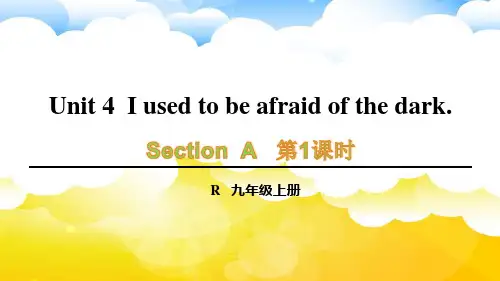

Unit 4I used to be afraid of the dark.一、教学目标:知识与技能: Knowledge and Ability Objects1.会写 , 会读 , 会用本节课的重点单词短语。
2. 熟练运用 used to do sth 谈论自己、他人过去的习惯、爱好、形象及经常做的事情。
过程与方法 : Method Objects in Teaching1.本课的生词和短语。
2. 通过听力练习,进一步掌握用 Used to do 谈论过去的喜好 3. 能够表达自己现在和过去在外表、性格、爱好等方面的变化。
通过阅读技巧的学习,让学生了解如何通过上下文猜测词意。
情感态度与价值观:培养学生克服困难,战胜自己的勇气,特别是如何用爱来感动学友。
二、教学重点:掌握 used to do句型三、教学难点:学会表达自己现在和过去在外表、性格、爱好等方面的变化四、教具准备: PPT录音机五、授课类型:新授课六、课时安排:本单元共 5 课时:Section A (1a— 2d)1 课时Section A( 3a—4c)1 课时Section B (1a— 1e)1 课时Section B (2a— 2f )1 课时Section B (3b-self check)1课时七、备课时间: 2015.9.22八、教学过程Section A (1a-2d)复备栏1.情景引学Step 1: Lead-inWe have been together for over two years. Do you remember whathe was like before? /in Grade One? What does he look like now?Compare two or three students or teachers. Let students tellsomething about their appearance or personality.Write “ He was short in Grade OneBut. he is tall now.”Today we learn a new sentences He used“ to be short. But heis tall now . ”2. 自主探学Step 2: explain “ usedto be/do ” “He used to play computergames every day. But now he study really hard.”Let students describe their partner. Please use“ used to do /be”Step 3: Deal with activity 1aTurn to p25, let’ s look1aat.Please write down the words as manyas possible. if you want to know others’ appearance or personality, we can ask:“ What does he look like?/ What’ s he like?”3.合作研学Now I want to know something about yourself. “ What’yourschange? ” Please use “ I used to ⋯I ,but⋯”nowFour students a group.4.变换拓学Step 4: Deal with 1b and 1c.Let ’looks at the picture. and could you tell us what are theirchanges?Listen to the tape and do 1bStep 5: deal with 2a and 2b.Listen to the tape and do 2a and 2b重点句型:1. I used to be afraid of the dark.我过去常常怕黑。
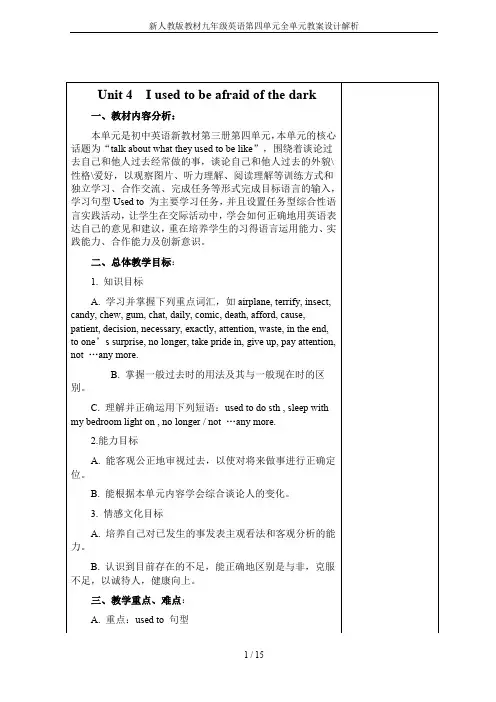
Teach the students to love studying and try to find the best and most3.How to use verbs.4.Describing a person.Ⅲ、学情分析本课时Section B的3a是一篇中长文章内容主要是作者谈到他现在遇到的最在问题,同样也是以比较的形式来描述。
3b补全一篇短文,加深对used to的运用,提高学生的写作能力。
3c主要是运用used to 写一篇自小学以来自己各方面发生了哪些变化。
Ⅴ、教学资源:Multi-media equipment.VI、教学方法:Focus on the students’training. Try to find out and solve problems through practical applying.VII、教学过程:Step 1 Revision1. Greetings .2. Check the homework .Step 2 ReadingSB Page 6 , 3a .1. Read the instructions and make sure students know what to do .2. Give students several minutes to read the article and finish the task .3. After students finished ,ask one student to write his/her answers on the blackboard.4. Correct the answers .5. Ask one volunteer to read the article aloud to the class ,offer assistance if necessary .Step 3 WritingSB Page 6 , 3b .First ,have students finish the letter on their own ,while they areworking ,walk around and give them some help .Then ask two students to read their letter aloud to the class .Finally answer some questions the students may have .Step 4 InterviewSB Page 6 ,Part 4 .1. Read the instructions and explain how to finish this task .2. Divide the class into groups of four. In each group ,each student takes turn interviewing the other students and take notes .3. Ask some groups to tell the class about their answers .Step 5 Self-checkSB Page 7 , Part 1 .1. Students finish it on their own first ,then check the answers with the whole class .2. Ask some students to make their own sentences with these words orally .SB Page 7 , Part 2 .You should have the courage of your opinions.Ⅱ.Teaching Key Points1.I used to be really quiet.I know. Now you are very outgoing.2.Did you use to have straight hair?Yes,I did.3.Did you use to play the piano?No, I didn't.II.教学重难点:1.Yes/No questions with used to2.Statements with used toⅢ、学情分析本课时为第一单元第五课时内容。
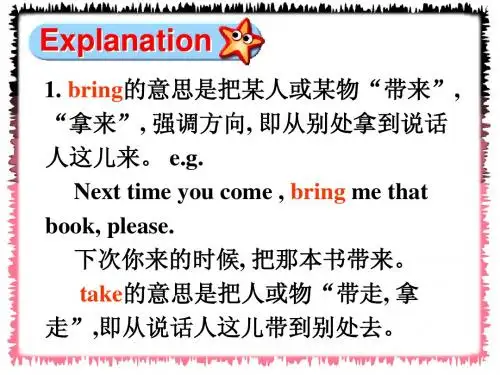


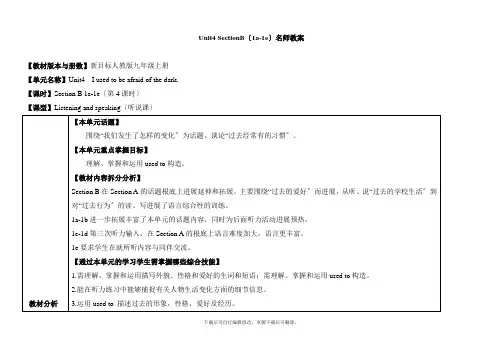
Unit4 SectionB〔1a-1e〕名师教案【教材版本与册数】新目标人教版九年级上册【单元名称】Unit4 I used to be afraid of the dark.【课时】Section B 1a-1e〔第4课时〕【课型】Listening and speaking〔听说课〕【本课时教学设计】.DE LC5 2 获取新知识Step2Pre-listening〔听前〕(6 mins)Work on 1a1.Show some pictures and learn the new words likethis:T: Did you use to like this when you were a child?S: I used to like (catching) ants/(watching)insects.T teaches the new words, Ss read and understandthem.2.Call Ss’ attention to the pictures in 1a. Try tounderstand the activities in the pictures.E. g T: what are they doing in Picture 1?S: They are having a music class.3.Ask Ss to check the things they like to do whenthey were a child. Ss finish 1a4.Check the answers by asking different Ss toreport his work .Work like this.T: What did you use to like to do when you were achild.S:I used to like painting pictures when I was achild.Work on 1b1.T asks “what other things did you use to like todo when you were a child?〞. Ss try to write somesentences in the box above. Then ask some students扫清词汇障碍,为后续听力活动中谈论过去的学校生活做准备。
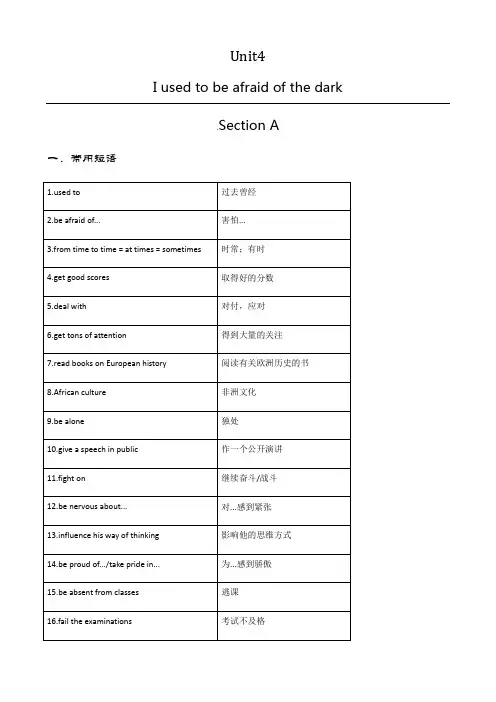
Unit4I used to be afraid of the dark.Section A一.常用短语二.考点精练▶考点一反义疑问句的用法这是一个反意疑问句。
此类反意疑问句的结构为:肯定的陈述句+ 否定的附加问句→“前肯后否”否定的陈述句+ 肯定的附加问句→“前否后肯”注意:前后两部分的人称数和时态等必须要保持一致!➩She doesn’t like shopping, does she? 她不喜欢购物,是吗?➩Your father went to the park, didn't he? 你爸爸去公园了,是吗?➩You don’t like classical music, do you? 你不喜欢古典音乐,对吗?【拓展】①对反意疑问句的回答,不管问题的提法如何,如果事实是肯定的用yes,事实是否定的用no。
②陈述句部分含有few(几乎没有)、little(几乎没有)、seldom(几乎不)、hardly(几乎不)、never(从不)或nothing(没有任何东西)等否定词,附加问句要用肯定形式。
➩He has never been to London, has he? 他从来没有去过伦敦,是吗?【易错提醒】无论何种形式的反意疑问句,依据事实来回答即可。
如果事实是肯定的,要用yes;如果事实是否定的,要用no。
只是要注意“前否后背”的答语中,yes和no与汉语意思正好相反。
➩He didn't pass the exam, did he? 他没有通过考试。
——Yes, he did. 不,他通过了。
(事实是肯定的)——No, he didn’t. 是的,他没有通过。
(事实是否定的)【小试牛刀】1.-- Steven had nothing for breakfast this morning, ______________ ?--No. Because he had a fever.A.hadn't heB.had heC.didn’t heD.did he2.David never fights with his classmates, _____________ ?A.does heB.doesn’t heC.is heD.Isn’t he答案:1.D2.A▶考点二 What + be + 主语 + like? 的用法2.What’s he like now? 他现在是什么样子?(P25 1c)1)What + be + 主语+ like? 用于提问人的外貌,译为“某人长什么样?”,相当于”What do / does + 主语+ look like?”,用于提问人的外貌(身材或长相)。
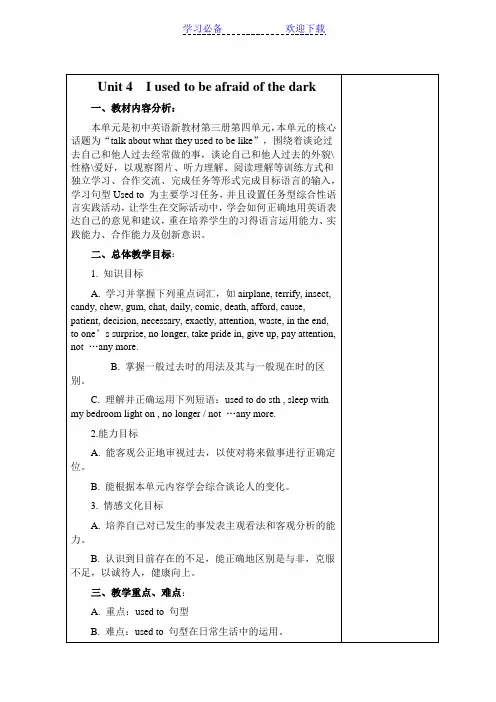
1.Understanding of the passages.2.Methods of expressing ways of studying different subjects.Ⅲ、学情分析本课时是第一单元第三课时。
本单元的话题非常接近学生的现实生活,谈论刚过去的生活是学生较喜欢、较乐于去交流的话题。
通过本单元的学习,引导学生学会使用讨论合作、信息采集、比较等学习策略。
Ⅳ、Teaching tools:1. A tape-recorder.2.Several flashcards.Ⅴ、Teaching methods:Help the students to use dictionaries in reading to deal with the new words and try to understand them according to the context.VI、Teaching process:Step 1 RevisionAsk some students how they study English ,get them to answer individually .Step 2 ReadingSB Page 4 , 3a .1. First ,ask one volunteer to read the article aloud to the class .2. Have students read through the passage one or two times and complete the chart on their own .3. Correct the answers .Step 3 PairworkSB Page 4 , 3b .1. Read the instructions to the class and ask a pair of students to practice the sample conversation .2. Then in pairs ,have students make their own conversation according to activity 3a .3. Ask some pairs to present their conversations .SB Page 4 , Part 4 .1. Ask students to check what they do to learn English in thechart .Then get them to work in pairs to interview their partner .2. Call some pairs to act out their dialogues in front of the class .Step 4 PracticeSB Page 5 , 1a & 1b .1. Ask one student to read the sentences to the class .2. Then have students check the statements which are true for them and ask them to add some other different things .3. Ask several students to write their lists on the blackboard and discuss them with the whole class .Step 5 ListeningSB Page 5 , 2a & 2b .1. Ask two students to read the challenges and solutions .Ifnecessary ,have students repeat after you .2. Play the recording two or three times ,let students listen and finish the work .3. Ask one student to have his/her answers with the class .4. Correct the answers .Step 6 PairworkSB Page 5 , 2c .In pairs ,students role play conversations using the information from activity 2a and 2b .Then ask some pairs to present their dialogue to the class .Step 7 HomeworkWrite an article to introduce how you study English.板书Unit 2 I used to be afraid of the dark设计:课后反思:Period 4教学内容: Section B 3a, 3b , 3c ,Ⅰ、教学目标知识目标: Make the students grasp the usage of “used to do sth.”能力目标: Help the students to describe a person using the materials offered.Teach the students to love studying and try to find the best and most suitable way.Ⅱ、教学重难点3.How to use verbs.4.Describing a person.Ⅲ、学情分析本课时Section B的3a是一篇中长文章内容主要是作者谈到他现在遇到的最在问题,同样也是以比较的形式来描述。
2020年⼈教版英语九年级unit4全单元学案(⽆答案)2020学年⼈教版英语九年级Unit 4 I used to be afraid of the dark.第⼀课时(Section A 1a-1c)⼀、学习⽬标1 熟练运⽤used to do sth谈论⾃⼰、他⼈过去的习惯、爱好、形象及经常做的事情。
2 能够听懂有关学习⽅法的简短对话。
3能运⽤used to 来谈论过去。
⼆、学习重难点1熟记重点单词短语。
2 正确使⽤used to三、学习步骤⼀、导⼊used to的⽤法“used to+动词原形”表⽰过去常常⼲某事,现在不在⼲了。
只有⼀种形式,即过去式。
例如:I used to go to work by bus. Now I take a taxi.So the sentence “I used to be afraid of the dark.” means in Chinese:我过去常害怕⿊暗。
“used to”的疑问形式和否定形式:—Did you use to be afraid of the dark?—Yes, I used to be afraid of the dark.—Did he use to be afraid of the dark?—No, he did not use to be afraid of the dark._There used to be a church here ,didn ‘t there ?跟踪练习(1) He______ ______ ____ after school. 放学后他过去常常踢⾜球。
(2) He ____ ______ _____ __________________. 他过去不吸烟。
(3)He used to play football. (改为⼀般疑问句,再回答)_______________________________________________________⼆、⾃学朗读、翻译短语I haven’t seen you for four years! a couple of days.Now I’m tall. And so are you! you used to wear glasses.you’ve changed! You used to have short hair.you used to be really tall! Not anymore.it used to be red, didn’t it? it used to be curly.You used to be short, didn’t you? 复习反意疑问句,完成练习:(1)Lily will go to China, ______ _____?(2)She doesn’t come from China, ________ ________?(3) You haven’t finished homework, _________ __ ?(4) He knows little English, _________ ______?三、交流注意谈论外貌和性格的不同句型What’s he\ she like ?What does he\ she look like?完成1a两⼈⼀组谈论⾃⼰过去的外表、性格等及与现在的不同。
Step 1 Revision&Ask some students how they study English ,get them to answer individually .Step 2 ReadingSB Page 4 , 3a .1. First ,ask one volunteer to read the article aloud to the class .2. Have students read through the passage one or two times and complete the chart on their own .3. Correct the answers .Step 3 PairworkSB Page 4 , 3b .#1. Read the instructions to the class and ask a pair of students to practice the sample conversation .2. Then in pairs ,have students make their own conversation according to activity 3a .3. Ask some pairs to present their conversations .SB Page 4 , Part 4 .1. Ask students to check what they do to learn English in thechart .Then get them to work in pairs to interview their partner .2. Call some pairs to act out their dialogues in front of the class .Step 4 PracticeSB Page 5 , 1a & 1b .(1. Ask one student to read the sentences to the class .2. Then have students check the statements which are true for them and ask them to add some other different things .3. Ask several students to write their lists on the blackboard and discuss them with the whole class .Step 5 ListeningSB Page 5 , 2a & 2b .1. Ask two students to read the challenges and solutions .If necessary ,have students repeat after you .2. Play the recording two or three times ,let students listen and finish the work .3. Ask one student to have his/her answers with the class .~4. Correct the answers .Step 6 PairworkSB Page 5 , 2c .In pairs ,students role play conversations using the information from activity 2a and 2b .Then ask some pairs to present their dialogue to the class .Step 7 HomeworkWrite an article to introduce how you study English.板书设计:课后反思:($Unit 2 I used to be afraid of the darkPeriod 4教学内容: Section B 3a, 3b , 3c ,Ⅰ、教学目标知识目标: Make the students grasp the usage of “used to do sth.”能力目标: Help the students to describe a person using the materials offered.Teach the students to love studying and try to find the best and most suitable way.~Ⅱ、教学重难点3.How to use verbs.4.Describing a person.Ⅲ、学情分析本课时Section B的3a是一篇中长文章内容主要是作者谈到他现在遇到的最在问题,同样也是以比较的形式来描述。
Unit 4 What would you do第一课时单元分析与提示教学目标语言目标:1、掌握虚拟条件句,注意动词的形式;2、熟练运用以下句型和词汇A.What would you do if you found a million dollars ?I’d give it to medical research. / If I were you, I’d buy some books.B. I can’t sleep before an exam. What shoul d I do?If I were you, I’d take a long walk before going to bed.3、词汇:charity, lottery, million, pimple, nervous, shy, creative, outgoing, confident, energetic, present, shirt, tie, medical research, give a speech, in public, introduce…to…, in the s lightest, would rather, let sb. down,认知目标学生能运用虚拟语气来讨论一些虚拟的情景并且能针对面临的问题给出建议。
情感目标通过对一些情景的反应,培养学生的应变能力;树立关爱他人的意识,形成开朗乐观的性格。
教学重、难点虚拟语气表示说话人的愿望、假设、猜测或建议,而不表示客观存在的事实,虚拟语气通过谓语动词的特殊形式来表示。
虚拟条件句谓语动词的构成形式:注意:主句中的should通常用于第一人称,would可用于任何人称,同时也可根据意思用情态动词could, might等代替should, would.1)表示与现在事实相反,例如:If I were you, I should stay at home.If the peasants could farm the land themselves, food production would be much higher.2)表示与过去事实相反,例如:If you had come yesterday, you would have met him.3)表示与将来事实相反,例如:If you came tomorrow, we would have the meeting .4)当条件状语从句表示的行为和主句表示的行为所发生的时间不一致时,动词的形式要根据它表示的时间来调整。
英语九年级上册第四单元教学案Section A 第一课时一、课前预习:翻译下列句子或短语millions of ______ worry about _______ take a long walk _______get nervous ______ give it to charities ______ what if ________1.If I were you , I’d wear a shirt and tie.2.What if everyone else brings a present ?3.The food you eat could help with this problem .用正确的词语填空。
If I were you , I’d do sth.4.I don’t know what ___ wear.5.If I ____ you, I’d wear a shirt and tie.6.If I _____(win) a million dollars in the lottery,I’d give it to medicalresearch.二、重点讲解及课堂练习重要单词、词组lion n. 百万注意:修饰名词时与具体数字连用,不用复数。
a capital of ten million dollars. 一千万美元的资本。
表示笼统数字时用millions of :数百万的,无数的2. pretend to do sth.假装做某事I pretended to sleep just now.pretend +从句假装… I pretended that I fell asleep.3. be late for 迟到如:I am late for work/ school/ class/ party.4. a few 与a little 的区别,few 与little 的区别⑴a few 一些(修饰可数名词) a little 一些(修饰不可数名词)两者表肯定意义如:He has a few friends. 他有一些朋友。
There is a little sugar in the bottle. 在瓶子里有一些糖。
⑵few 少数的修饰可数名词little 少数的修饰不可数名词但两者表否定意义如:He has few friends. 他没有几个朋友。
There is little sugar in the bottle.在瓶子里没有多少糖。
5. still 仍然,还用在be动词之后,行为动词之前如:I am still a student.我仍然是个学生I still love him.我仍然爱他。
6. hundred, thousand , million, billion (十亿)词前面有数词或several一词时要不能加s ,反之,则要加s 并与of 连用,表示数量很多如:several hundred/ thousand/ million/ billion people几百/千/百万/十亿人hundreds of trees 上百棵树7. what if + 从句如果…怎么办,要是… 又怎么样如:What if she doesn’t come? 要是她不来怎么办?What if LiLei knows? 如果李雷知道了怎么办?8. add sth. to sth. 添加…到… 如:I added some sugar to water. 我把糖添加到水里。
9. 系动词与形容词连用get nervous 变得紧张feel shy 觉得害羞look friendly 看起来友好10. too +形/副+to do sth. 太…而不能如:I’m too tired to stand. 我太累了而不能站。
11. help with sth.如:They help with this problem.help sb. do.如:They help you relax. 他们帮助你放松12. in public 在公共场所如: Don’t smoke in public. 请不要在公共场所吸烟。
13. energetic adj. 活力的如:She is a energetic girl. 她是一个活力的女孩。
energy n. 活力如:She has lots of energies. 她有活力。
14. ask sb. to do 叫…做某事ask sb. not to do sth.叫…不要做某事tell sb. to do 告诉…做某事tell sb. not to do sth. 告诉…不要做某事如:Teacher asked me to clean the classroom.Teacher asked me not to clean the classroom.15. start doing == start to do. 开始做某事如:He started speaking/ to speak. 他开始说话。
16. borrow sth. from sb. 从某人那里借来某物如:I borrowed a book from Lily. 我从莉莉那里借来一本书。
17.wait for sb.等某人如:I am wait for him. 我正在等他。
18. introduce sb. to sb. 把某人介绍给某人如:I introduced Lily to Anna. 我把莉莉介绍给安娜。
19. invite sb. to do 邀请某人做某事如:Lily invited me to go to her home for supper. 莉莉邀请我去她家吃晚饭。
20. have dinner/ supper 吃晚饭have lunch/ breakfast 吃午餐、吃早餐21. plenty of 修饰不可数名词,也可以修饰可数名词许多如:They have plenty of food/ apples. 他们有许多的食物/苹果。
22. 给某人某物give sth. to sb. 如:give an apple to megive sb. sth.give me an apple 给我一个苹果23. get along with sb. 与…相处如:Do you get along well with your friends? 你和你的朋友相处得好吗?24. would rather do sth. than do sth.表示愿做某事而不愿做某事如:I would rather walk than run.25. whole 整个26. in fact 事实上27. let sb. down 让某人失望如:Don’t let your mother down.不要让你的妈妈失望。
28. come up with sth.提出想出如:He came up with a good idea. 他提出了一个好主意。
catch up with sb.追上赶上如:Lily caught up with Anna. 莉莉赶上了安娜。
29. have experience doing在做某事有经验如:I have experience teaching Chinese. 我在教英语方面有经验。
30. come out 出版,出来如:The magazine comes out once a week. 这种杂志每周出一次。
31. by accident偶然地,无意之中如:Last week I cut my finger by accident. 上个星期我不小心割到自己的手指。
32. hurry to do匆忙… I hurry to call the police. 33. more than超过34. offer sb. sth. 给某人提供某物语法知识归纳:宾语从句宾语从句在复合句中作主句的宾语。
由连接词+ 主语+ 谓语构成常由下面的一些词引导:㈠由that 引导表示陈述意义that 可省略He says (that) he is at home. 他说他在家里。
㈡由if , whether 引导表示一般疑问意义(带有是否、已否、对否等)I don’t know if / whether Wei Hua likes fish.我不知道韦华是否喜欢鱼。
㈢由连接代词、连接副词(疑问词) 引导表示特殊疑问意义Do you know what he wants to buy? 你知道他想要买什么吗?㈣从句时态要与主句一致当主句是一般现在时,从句根据情况使用任何时态He says (that ) he is at home. 他说他在家里。
I don’t know (that) she is singing now. 我不知道她正在唱歌。
She wants to know if I have finished my homework.她想要知道我是否已经完成了我的作业。
Do you know when he will be back? 你知道他将会什么时候回来?当主句是一般过去时,从句应使用过去某时态(一般过去时,过去进行时,过去将来时,过去完成时)He said (that) he was at home. 他说他在家里。
I didn’t know that she was singing now. 我不知道她正在唱歌。
She wanted to know if I had finished m homework.她想要知道我是否已经完成了我的作业。
Did you know when he would be back? 你知道他将会什么时候回来?三、重点句型解读:1.What would you do if you had a million dollars ?用法:if引导的虚拟的条件状语从句,从句为非真实条件句。
非真实条件句是指假设的条件与事实相反或不可能实现。
当虚拟语气与现在事实相反时,从句用一般过去时。
主句用should /would/could /might + 动词原形。
1)If I had time , I would go for a walk. _____________________2)If I were invited , I would go to the dinner party.(翻译)___________________________________________3)If I won a million dollars in the lottery, I would put it in the bank.__________________________________________2. He doesn’t know if he should bring a present.用法:1)此处if 表示“是否”,相当于whether ,引导宾语从句。